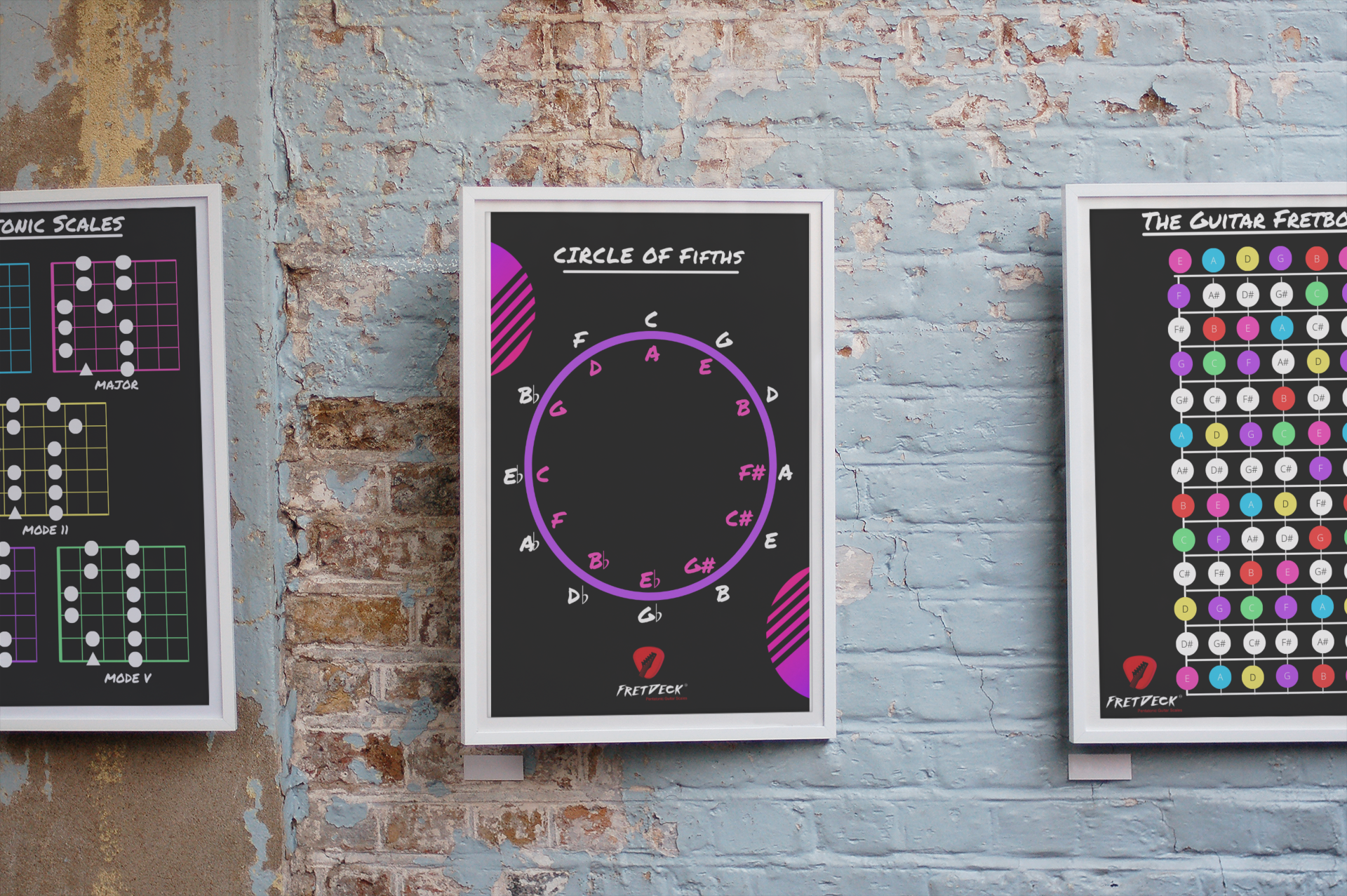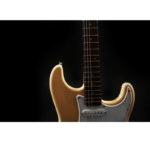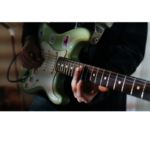If you’ve been playing guitar for a while and want to expand your harmonic vocabulary, understanding and using triads on guitar is an essential step. Triads are foundational building blocks in music, offering simplicity and flexibility when crafting chord progressions and rhythm parts. This article will dive deep into what triads are, how to form and use them, their role in chord progressions, rhythm playing, and the importance of triad inversions.
What Are Triads on Guitar?
A triad is a basic three-note chord constructed from the first (root), third, and fifth notes of a scale. For instance, a C major triad consists of the notes C (root), E (major third), and G (perfect fifth). Triads come in four basic types:
- Major Triads – Root, major third, and perfect fifth (C-E-G)
- Minor Triads – Root, minor third, and perfect fifth (C-E♭-G)
- Diminished Triads – Root, minor third, and diminished fifth (C-E♭-G♭)
- Augmented Triads – Root, major third, and augmented fifth (C-E-G♯)
These triads form the basis of harmony in most genres of music. They can be played in different positions on the guitar, providing both melodic and harmonic opportunities.

Download FREE Guitar Charts!
We have 27 FREE guitar charts to help you learn the guitar fretboard. Learn How to play chords and scales with these free resources.
Free Guitar Resources
How to Form Triads on Guitar
Triads can be played across different sets of strings on the guitar. The most common triad shapes are formed on the following string sets:
- String Set 1: High E (1st), B (2nd), and G (3rd)
- String Set 2: D (4th), G (3rd), and B (2nd)
- String Set 3: A (5th), D (4th), and G (3rd)
For example, if you want to play a C major triad on the first string set, you would use the following notes:
- G on the 3rd string
- E on the 2nd string
- C on the 1st string
This shape can then be moved up and down the neck to create triads based on other roots, keeping the relationship between the notes the same.
Major and Minor Triads in Chord Progressions
Incorporating triads into chord progressions allows you to add a new layer of harmonic richness to your playing. A common progression using major and minor triads might follow a I-IV-V pattern. Let’s break down a simple example in the key of G major:
- I (G major): G (root) – B (major third) – D (perfect fifth)
- IV (C major): C (root) – E (major third) – G (perfect fifth)
- V (D major): D (root) – F♯ (major third) – A (perfect fifth)
These triads can be played in various positions along the neck, allowing for smoother transitions between chords. By using triads in different voicings, you can achieve more dynamic, compact chord movements. This becomes especially useful when you’re playing in a band, helping you avoid clashing with other instruments by staying out of the bass player’s range or complementing the higher register of a lead instrument.
The Power of Triads in Rhythm Guitar Playing
Rhythm guitarists frequently use triads to provide clarity and rhythmic precision to their playing. Full six-string chords can often sound muddy, especially in a busy mix. Triads focus on just three essential notes, leaving more space for other instruments and creating a cleaner sound.
For example, in funk or R&B rhythm playing, players like Nile Rodgers (Chic) often use triads to keep their rhythm parts sharp and percussive. Triads allow you to play quick, rhythmic chord stabs without the thickness of full chords, making them perfect for genres that demand tight, syncopated rhythms.
Here’s how you can apply triads in a typical rhythm playing situation. Let’s take a simple progression in the key of A major:
- A major: Root (A), major third (C♯), perfect fifth (E)
- D major: Root (D), major third (F♯), perfect fifth (A)
- E major: Root (E), major third (G♯), perfect fifth (B)
Instead of strumming full open chords, you can use triads to play partial chords higher up the neck, creating a rhythmic groove. For example:
- A major triad on the 7th fret (5th, 4th, and 3rd strings)
- D major triad on the 7th fret (4th, 3rd, and 2nd strings)
- E major triad on the 9th fret (4th, 3rd, and 2nd strings)
These simple shapes offer endless possibilities for groove-based playing.
Exploring Triad Inversions
One of the most exciting aspects of triads on guitar is the ability to use inversions. An inversion is when you play the same three notes of a triad but with a different note in the bass. This allows you to achieve smoother voice leading in chord progressions and explore new sonic textures.
There are three possible ways to play any triad:
- Root Position: The root of the triad is the lowest note (e.g., C-E-G for a C major triad).
- First Inversion: The third of the triad is the lowest note (e.g., E-G-C for a C major triad).
- Second Inversion: The fifth of the triad is the lowest note (e.g., G-C-E for a C major triad).
Let’s break down how these inversions work with a C major triad:
- Root Position: C (3rd fret, 5th string), E (2nd fret, 4th string), G (open 3rd string)
- First Inversion: E (7th fret, 5th string), G (5th fret, 4th string), C (5th fret, 3rd string)
- Second Inversion: G (10th fret, 5th string), C (10th fret, 4th string), E (9th fret, 3rd string)
By incorporating these inversions, you can create more interesting and less predictable chord progressions. For example, using inversions in a progression like C – G – Am – F allows for smoother transitions between chords, since the bass notes move in smaller steps.
How to Use Triads in Common Chord Progressions
Let’s take a typical chord progression in the key of C major: C – F – G. Using triads, you can find multiple ways to play this progression up and down the neck.
Here’s one way to play it using root position triads:
- C major (Root Position): C (5th fret, 3rd string), E (5th fret, 2nd string), G (5th fret, 1st string)
- F major (Root Position): F (3rd fret, 4th string), A (2nd fret, 3rd string), C (1st fret, 2nd string)
- G major (Root Position): G (4th fret, 3rd string), B (4th fret, 2nd string), D (3rd fret, 1st string)
Now, here’s how it looks using first inversions:
- C major (First Inversion): E (9th fret, 4th string), G (8th fret, 3rd string), C (8th fret, 2nd string)
- F major (First Inversion): A (7th fret, 4th string), C (5th fret, 3rd string), F (6th fret, 2nd string)
- G major (First Inversion): B (7th fret, 4th string), D (7th fret, 3rd string), G (7th fret, 2nd string)
This provides more variety in sound and a better understanding of the fretboard. By exploring these variations, you can make even the simplest chord progressions sound unique.
Using Diminished and Augmented Triads for Tension
Beyond major and minor triads, you can also incorporate diminished and augmented triads into your playing to create tension and release. These triads often serve as transition chords in jazz, blues, and classical music.
For example, using a diminished triad between two major chords can create a chromatic movement that enhances the harmonic progression. In the key of C major, you might use a B diminished triad (B-D-F) to move from C major to G major.
Similarly, an augmented triad can add a dreamy, unresolved quality to a progression. The C augmented triad (C-E-G♯) could be used to transition into an A minor chord, adding color and complexity.
Conclusion: Mastering Triads on Guitar
Triads on guitar are a powerful tool that every guitarist should master. They provide clarity in rhythm playing, versatility in chord progressions, and a deeper understanding of the guitar’s fretboard. By learning how to use triads, including their inversions, you can unlock new levels of creativity in your music. Whether you’re playing in a band, crafting intricate chord progressions, or experimenting with rhythm parts, triads are a key element of effective guitar playing.

Download FREE Guitar Charts!
We have 27 FREE guitar charts to help you learn the guitar fretboard. Learn How to play chords and scales with these free resources.
Free Guitar Resources










